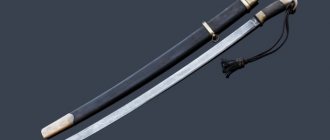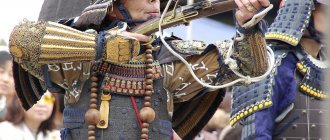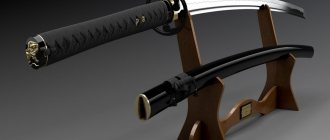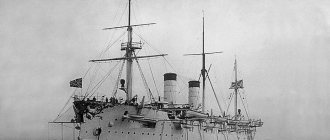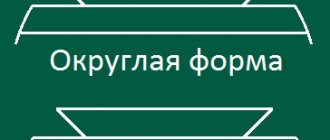They showed me something marvelous: the “checker vs katana” battle scene from the movie “Courier of Special Importance.” There, the main character, for some reason of his own (really, I didn’t get into the essence), fights with the Japanese using the mentioned weapon.
Specifically based on this episode, I can only say that I haven’t come across a more lame claim to combat fencing in a long time. Everything is wrong there, from the initial stances to straight, hard blade-to-blade blocks (for those who don’t know, you should absolutely not do this with a saber or a katana). In general, brothers in arms, I recommend it to anyone who wants to laugh...))
But then I began to wonder, what can you basically count on when such different blades collide in battle? There have been cases, especially during the Russian-Japanese...
Legend or myth?
I very often came across stories (most similar in style to stories) that a Russian Cossack with a saber in that war dominated a samurai with a katana, like a complete sadist over a masochist in BDSM games. However, I personally have not met anywhere confirmed
such cases - for example, in the notes of journalists of that time, orders for awards - in a word, at least in some documents.
Maybe it's just me not being aware of it. Quite. However, I am a person who reads, and on the topic, and quite a lot...))
The only real one
a case of a clash between a checker and a katana in battle on the fields of the Russian-Japanese War, documented, from my collection - this is an article from a British newspaper that describes a duel between a Russian and Japanese officer with edged weapons. The Russian died.
Unfortunately, the article does not mention what the Japanese were armed with. We can only assume that it was a kyu-gunto sword (essentially a katana with a saber bow), which was then in service with the Japanese, but it could also be a European-style saber. Then they are a surprise! — They were in Japan, and samurai studied European fencing.
Yes, and there is also some distrust of the British source, to be honest...
If this case is true, then purely theoretically it can be assumed that a Japanese could know the features of the European style, while a Russian probably did not know Japanese. Kenjutsu was completely unknown in Russia in the 19th and early 20th centuries. It began to spread immediately after the REV.
And, by the way, one knowledgeable person from an old Cossack family (a real Cossack, not one of the mummers) told me that it was after that war that the Cossacks began to practice a two-handed grip on a saber. Yes, it’s inconvenient, the handle is wrong. But how much more efficient does cutting become...)
In general, gentlemen, make yourself comfortable. Let's begin our favorite pastime - free theorizing)))
Early European sabers
It should be noted that in addition to weapons of the eastern type, Europeans also developed their own saber-cleavers from the falchions:
- the Venetian and Genoese cortelas had a slightly curved, wide, long blade;
- Venetian storta, a single-sided straight blade that widens towards the tip;
- badeler, a half-saber with a wide curved blade that widens towards the tip;
- krakemart, a long-bladed weapon with a double-edged sharpening;
- Marcus, a curved blade and an open saber hilt, is the heir to the ancient Egyptian khopesh, with a slight bend and internal sharpening.
Almost all of these types of sabers had a regular sword handle, with a simple straight crosspiece, less often with a bow covering the hand. But these types of sabers received virtually no development.
The classic saber originates from Hungarian sabers and Polish carabelas. And they, in turn, are from eastern weapons.
Matching the blades
For comparison, let's take more or less standard weapons - a Russian army saber and a factory-made Japanese katana. Those who want to focus on historicity can take the kyu-gunto - a katana-shaped sword with a saber bow, which was then in service in Japan, but personally I am interested in comparing precisely the “classic”, standard samples.
The blade length of a katana and a checker are approximately the same.
Shown here is a slightly longer katana - possibly an o-katana
The checker will be a little wider, and the katana will be narrower, but the checker will have a wide fuller, and the katana will have a stiffening rib (fullers on Japanese swords are generally rare). Due to this, the weight of the weapon is also comparable - 900 g for a checker and approximately 1000-1150 g for a katana. The samurai sword is slightly heavier, but is held with two hands - due to this it has increased speed, accuracy and controllability.
A two-handed weapon with a comparable blade length, and even more so if it exceeds it, always has an advantage over a one-handed weapon in combat without shields. This is an axiom. A strike with two hands, especially using the effect of leverage (which the samurai knew very well) is incredibly powerful, it simply demolishes the weapon with which the opponent is trying to defend himself while holding it in one hand. If it comes to techniques using wrestling, and you need to put pressure on your opponent’s sword with your sword (this happens quite often), then the advantage again goes to the two-hander. Anyone, no matter what it's called.
Balancing
A katana can have both a chopping and a “fencing” balance - this depends on the wishes of the owner and is regulated by the thickness of the blade in the strong part (5-7 mm) and the presence or absence of a tsuba. Yes, a samurai sword may not have a tsuba; such a weapon is called “aikuchi”. According to Japanese concepts, the aikuchi katana is a claim that its owner considers himself an unsurpassed swordsman.
But how it really is there can only be found out in practice...))
Kyu-gunto, due to the mandatory guard and the presence of a bow, will have a “fencing” balance, that is, close to the guard.
By the way, the kyu-gunto, unlike the katana, is characterized by a narrow fuller hole in the upper part of the blade
The checker always has a chopping balance. Roughly speaking, a Japanese sword has an average balance of a palm from the guard, sometimes on the guard, while a checker has a balance of two palms from the hilt.
The controllability of a weapon in close combat depends on balance. The original purpose of the checker is to strike from the height of the saddle, the original purpose of the katana is close combat, a duel.
Therefore, with a saber it is necessary to make fairly sweeping, almost circular strikes from the shoulder along a long trajectory. Her style is “swell, shoulder, swing, arm!” Yes, real Caucasian checkers are much lighter, they weigh 600 grams, and, accordingly, more maneuverable - but we are considering a standard army one...))
A typical saber from the Russian-Japanese era. "Dragunka" differs only in the presence of a saber hilt
It turns out that in a duel, a fighter with a certain “average” katana will have an advantage over a fighter with the same “average” standard saber due to the two-handed grip and “fencing” balance of his weapon. They increase the controllability of the blade. In addition, a katana strike from two hands is almost equivalent in power to a saber strike from one hand - there the balance “works” on the quality of the cut, here it is a two-handed grip. We are not taking the stated striking technique into account yet, we are only talking about the properties of swords...
Evolution
The appearance of the saber was most likely due to the development of armor. The entire evolution of weapons is an endless competition of strike and defense. The long straight blade of the sword lost the battle to plate armor and was replaced by narrow broadsword blades and curved saber blades.
The main difference from a straight sword was precisely this; a curved blade was lighter, but at the same time it inflicted deeper wounds due to the bending of the blade.
In addition, this blade made it possible to use it in fencing, while heavy swords and broadswords were poorly suited for this.
The curved blade made it possible to cut off the tip of the spear during an attack, it required less steel for production, and it was simply more convenient. They first appeared in the East, the Turkish saber - klych and the Iranian shamshir are the most famous at present.
A little later a scimitar appeared. From the East, these weapons gradually came to Europe. It should be noted that the main route of penetration was the Hungarian and Polish principalities, and it was from there that the classic saber originated.
In Rus', despite all its advantages, it remained a weapon of the nobility.
This was due both to the low quality of domestic iron, mined mainly from swamp ore, and to the lack of full-fledged regular troops.
The situation changed radically only under Peter I, but even then swords and broadswords were adopted for service. A little later, the saber was adopted by the cavalry, and it was at this time that the Zlatoust plant became the main supplier of piercing and cutting weapons for the Russian army.
Comparing technology
Everything is complicated here. Firstly, the Japanese have many different schools with completely different ideas and teaching methods. There are schools in which the emphasis is on one single blow, but it is placed in such a way that an elephant in armor can be cut down. There are schools where many neat, moderately sneaky cutting techniques are practiced. There are schools where they teach the katana almost in the manner of a European sword, actively using injections, by the way.
The only thing a Japanese may not know (at least my teacher didn’t know) is a thrust with opposition, while simultaneously putting up a defense. But, most likely, even our hypothetical fighter with a saber does not know this - ordinary Cossacks and cavalrymen might not have been taught this. And if he knows, then he’s unlikely to be able to use it - for an injection with the opposition, gentlemen, you need a guard, at least a small one, at least a tsuba plate or at least the crosshair of a knight’s sword - it’ll do for the worst case...
Checkers in Russia could be taught according to two principles. The first is “soldier’s”, it was taught to lower ranks. There are three or four blows, the same number of thrusts and two or three simple defenses - by the way, by knocking down, in no case with a hard block!
Let me remind you: knocking down is a blow to the enemy sword in flight, forcing it to deviate its trajectory. A counterpunch of sorts, yes.
Ural Cossacks during the Russo-Japanese War
The second principle can be conditionally called “officer”. The checker was taught as a saber, with a discount for the lack of a guard. Saber technology in Russia in the 19th and early 20th centuries was very well developed, both “sports” (for example, the famous “Barbasetti saber”) and combat.
Russian “officer”, fully functional saber equipment was very good. But the problem is that few of the ordinary, combatant officers knew this technique then...
“The officer is armed with a revolver and a sword. The revolver is only good for 7 shots and then becomes useless. It is absolutely impossible to load and unload a modern-style revolver in minutes when seconds count. The checker remains. They usually take it during an attack. It is difficult to repel bayonet strikes with a saber, and therefore during a bayonet fight the officer is poorly protected if he does not have time to grab the rifle. But at the moment of attack there is no time to think about it. The position of the officer at these moments becomes even more difficult because the officers do not know how to wield a saber, since in most cases the saber serves the officer only for techniques. Our use of edged weapons is poor."
(c) Soloviev L.Z. “Indications of the experience of the current war on infantry combat operations. Impressions of a company commander." 1907
By “techniques” we mean not fencing exercises, but social receptions - where are the balls, the beauties, and further in the text...)
This concerns Russian officers. And the Cossacks - what are the Cossacks? How they knew how to wield a saber, only they themselves knew...
By the way, I came across mentions that in duels “Cossack vs samurai” the first killed the second while he was performing the military salute required by Japanese etiquette. It’s your choice, but this, firstly, is a malicious violation of any rules of honor, and secondly, it does not in any way indicate the superiority of Cossack fencing methods...
But it should be noted that in most Japanese techniques, defense is practiced in the same way by knocking down or draining, and not by using a hard block. And knocking down, performed with a two-handed sword, is twice as effective as knocking down, performed with a one-handed sword.
Simply put, with a katana it’s quite easy to deflect the blade of a saber or checker, but with a checker it’s quite easy to deflect a katana... Well, well, try it...)
As for the instant strike technique, it is found both in the “checkers” technique and in the Japanese one. But! In order to implement this blow, the enemy must already come within striking distance. And if he is ready for a fight, then with an equal level of skill he will get you first - the state of readiness means at least that the sword is already in his hands...)
Cossack attack on Japanese positions
conclusions
The katana, due to its two-handed grip and balance close to fencing, has a basic advantage over the checker in a duel. The tsuba will also play a certain role, which protects well at least from the enemy’s blade slipping along the blade of your actual sword to your hand (source - personal experience).
Just in case, let me remind you that most Japanese schools have targeted strikes to the hand. Samurai love them. If our hypothetical fighter with a saber is ready for this and knows how not to put his hands up, then he also has a chance to survive and win.
By the way, it was during that war that the fashion began for Russian troops to take Japanese swords as trophies. They were sometimes worn instead of service swords. If they didn’t give an advantage in battle, this wouldn’t happen...))
But in the end, the outcome of any battle is decided by the skill of the fighters. People win or lose, not weapons...
